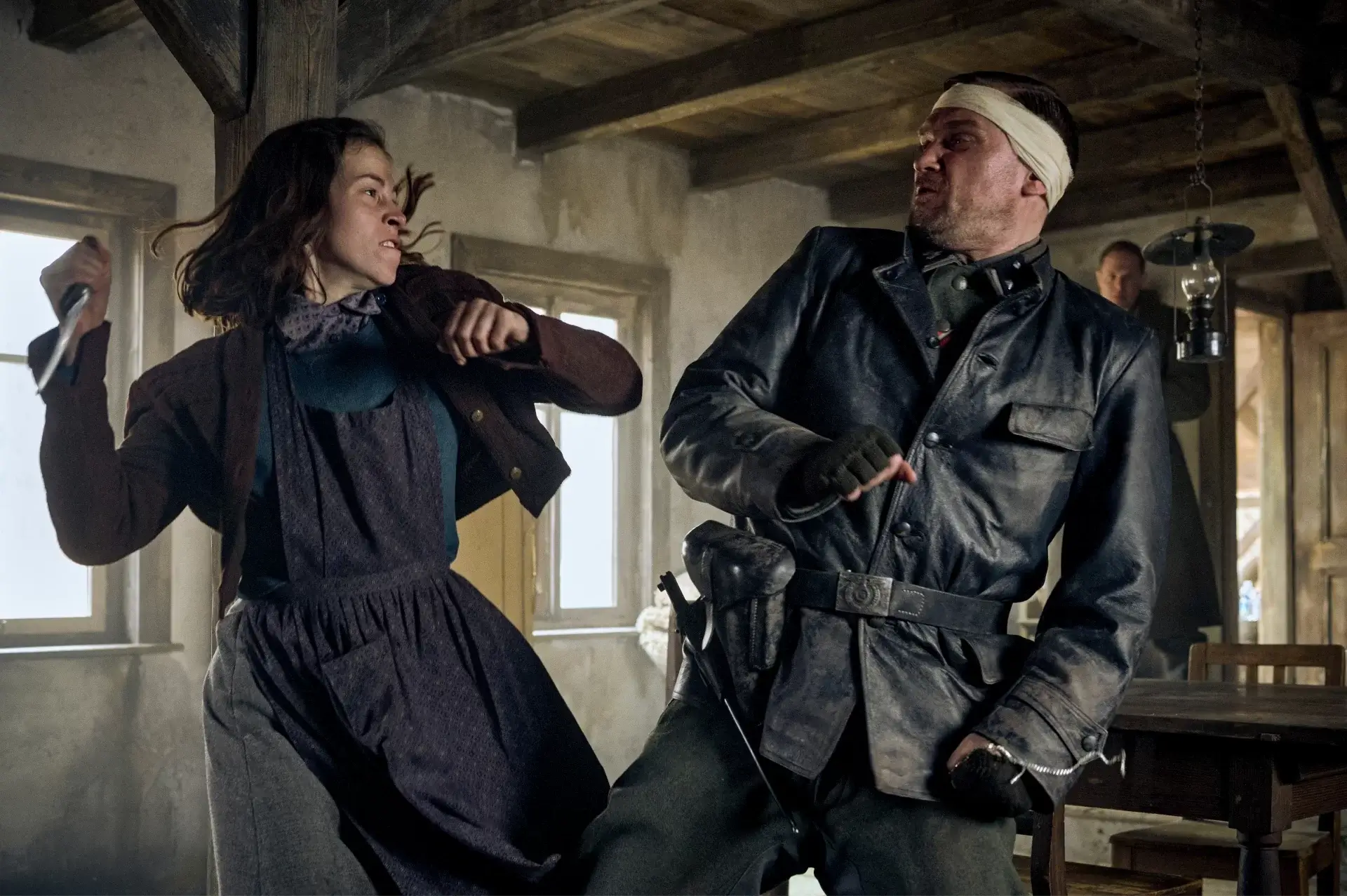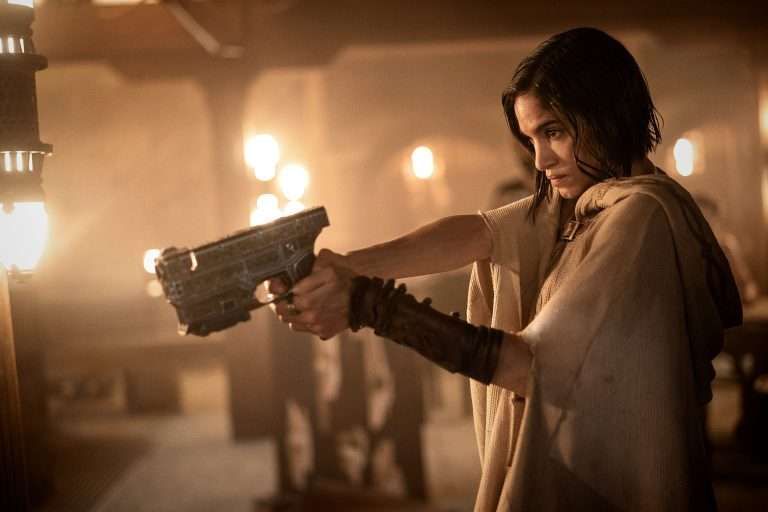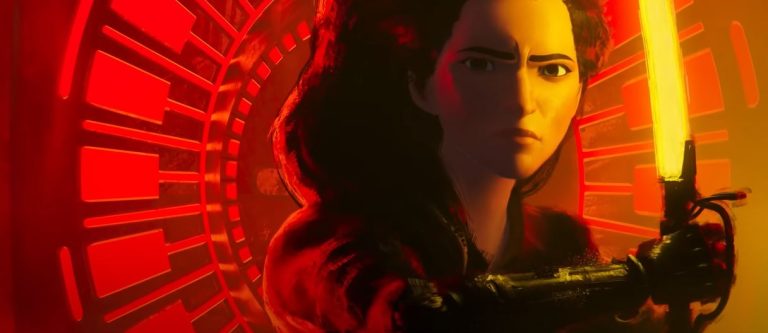Interestingly, the central story of the Netflix film Blood & Gold (Peter Thorwarth, 2023) does not revolve around an Allied vs Axis fight. It only forms the backdrop of the story. What we are presented with, instead, is the story of crevices within the military; the narrative of how a war veteran, even with the most prestigious Nazi military awards at his disposal, finally turned against the Nazi regime.
*Spoiler alert*
Blood & Gold (2023) Plot Summary & Movie Synopsis:
In the summer of 1945, a man is seen racing through the cold, gloomy expanse of the German countryside in an attempt to avert a Nazi military troop trying to gun him down. When the troop pins the man down, it is found out that this man is not an Allied soldier but a Waffen-SS Private himself. The reason for this chase becomes clear.
The man in question, despite serving Nazi Germany as a Private and being awarded with the most ‘decorated’ Iron Cross, has been at the war front for years reluctantly. However, now that the Nazi Germany is on the verge of the great fall, he wants to break free and revoke his loyalty to the Führer, Adolf Hitler. The man is convicted of treason by the lieutenant colonel of the SS troop. The military hangs him to a tree and leaves him in the middle of the field. However, he is saved just at the right time by a woman.
She takes him to her house in the outskirts which she shares with her brother and their beloved cow. The woman, Elsa, promises to help the soldier, Heinrich, take down the Nazis. She shares that their father was abducted and killed by the SS on the charges of incendiary speech. The same people, who helped the SS to capture their father, banished the sister and the brother from their farm. Before they could get a faint hint of the fact that the brother, Paule, has Down syndrome, Elsa ran away with him and settled in the outskirts of the forest.
On the other hand, the military is seen entering Sonnenberg, much to the horrors of the residents. They move to the town with a motive—to find the gold allegedly hidden under the debris of a Jew house which was torched and destroyed in the November pogrom of 1938. After moving to Sonnenberg, the lieutenant orders a foraging expedition to the surrounding farmyards to loot rations that would feed the starving soldiers. In the farmhouse, Heinrich reveals to Elsa that he is on the lookout for his daughter, Lottchen, who is the only surviving member of his family after the bombing of Hagen.
Soon, the SS truck moves to their farmhouse. After a heated altercation with Elsa, the Sergeant of the troop attempts to rape her. However, Heinrich saves Elsa and both of them manage to kill all the Nazi soldiers, barring the Sergeant who flees the site. Elsa, Heinrich, and Paule desert their farmyard, much to the dismay of Paule who is not happy at the prospect of leaving behind his cow. They spend the night in the forest but soon Paule disappears. He goes back to his house to his cow, Rita. The Sergeant, having come down again to the farmyard and not finding Heinrich and Elsa, captures Paule and Rita.
Elsa and Heinrich spot the truck and advance toward Sonnenberg to free Paule. Paule is paraded by the SS in the village square, with a board that reads “I am Unworthy of Life”. He is shoved up to the church steeple by the soldiers in order to be hanged and made a spectacle. However, he fights back and pushes a soldier to death. Paule takes charge of the situation, even if momentarily, and causes havoc with the gun of the Nazi soldiers that he has killed. Elsa and Heinrich arrive at the church but Paule does not sustain long and gets killed by the lieutenant. Enraged by her brother’s death, Elsa runs to the lieutenant to shoot him. Surprisingly, however, the colonel orders his troop not to shoot her.

Meanwhile, after an armed brawl with the army, primarily led by the Sergeant, Heinrich gets severely wounded and takes shelter at the house of the village priest who has been supporting them all along. When Heinrich asks what has led the SS here, the priest says they are here for the hidden gold of the Löwensteins, the Jew family. The priest also reveals that he has hidden the gold inside the altar of the church due to the varied bloodthirsty interests in it. Heinrich decides that the gold would be the only way to lure the SS towards him and free Elsa. By the time Heinrich arrives at the inn with the gold, Elsa has killed the lieutenant colonel by indulging in a fake kiss, done only to pass a cyanide capsule to his mouth.
Blood & Gold (2023) Netflix Movie Ending, Explained:
Does the SS get the Gold?
The Löwenstein’s gold has been the point of interest of every Nazi in Sonnenberg. The Mayor, his accomplices, the Nazi sympathizers, and now the recently arrived SS troops—every single party is seen outplaying each other to seize the gold. While the Sergeant captures Heinrich and threatens him to reveal the place where the gold is hidden, some Nazi residents of Sonnenberg find the connection of the priest in all this and drag him to the church to help them find it out before the SS.
Upon reaching the church, the villagers open the altar but they are killed by the grenades which are already planted amidst the gold as a trap. Right after that, the SS arrives and shoots the priest. Elsa and the old partner of the priest also arrive at the church to gun down the Nazis. Following a bloody battle, the old lady dies too. Elsa and Heinrich, although fatally wounded, manage to hunt down the Nazis and leave the church, leaving behind all the gold bars scattered around.
We see one Nazi soldier surviving the battle at the church and moving towards the gold bars but he too is shot by Sonja, the Nazi-sympathizing resident, who is now shown to have survived the grenade bombing. Cut to the end of the war, we see Sonja driving away in a German staff car with the radio announcing the death of Hitler. But the Americans, who have now made their way into Germany, detonate her car. They find the gold and decide not to report it but to keep it with them. Thus, the gold changes hands from the Nazis to the Imperialists.
Who are the Waffen-SS?
“From modest beginnings, the SS (Schutzstaffel; Protection Squadrons), became a virtual state within a state in Nazi Germany, staffed by men who perceived themselves as the “racial elite” of Nazi future”, notes the United States Holocaust Memorial Museum.
In the beginning, the SS had the primary duty to provide protection to Hitler and other Nazi leaders. However, after the Nazi Party came into power, the SS consolidated itself as a government pillar. The SS initiated and oversaw the concentration camps. To put simply, the Waffen-SS was the military branch of the SS.
“I am Unworthy of Life”
After coming to power in 1933, the Nazis did not only go after the Jews but also, with equal force, after the people with mental and physical disabilities. The Nazis had no qualms about cutting people with disabilities off from society and killing them. The terms “Life unworthy of life”, “useless eaters”, and “empty human shells” are Nazi inventions and exemplify the ruthless bigotry and the pseudoscience that formed the very essence of Nazism. The Nazi government was successful in engendering a seed of hate among the masses against people with disabilities by appealing to their ‘Aryan’ sensibilities.
They constantly referred to the hapless people as burdens who live off tax-payers’ money. The Nazi government used whatever mechanisms possible to exterminate those they deemed ‘unfit’ for society. In 1933, the Nazi government enacted the ‘Law for the Prevention of Offspring with Hereditary Diseases’, a law that forced sterilisation of disabled people; two years later, disabled people were blacklisted from schools.
Not long after, the Aktion T4 program was pushed ahead which advocated the killings of disabled people in gas chambers and, later, as it was advocated as a highly respectable field, in hospitals by specialized doctors. In the film, when the SS troop reaches Elsa’s farmhouse, upon seeing Paule, one of the soldiers passes the remarks “I thought vermin of your kind were eradicated”, alluding to the Aktion T4 program which was already underway.
What is Kristallnacht?
The November pogrom, due to which the Löwensteins had to flee the place they have so long called their home, is engraved in public memory as the Night of the Broken Glass or Kristallnacht. Between November 9 and 10, 1938, Adolf Hitler, powered by his propaganda minister Joseph Goebbels, sent his troops on Jew hunts. The SS forces and the Hitler Youth wreaked havoc and slaughtered the Jew population across Germany and the annexed territory of Austria with the desire to create a completely ‘sanitised’, ‘pristine’ Third Reich.
Totenkopf, the image of the skull
“Death’s head”, or Totenkopf in German, is the infamous insignia of the SS. Wearing the death’s head is something akin to wearing the heart on the sleeve– only the heart is the skull and the sleeve is the Nazi military uniform. We see it on the motorbike that the Sergeant rides. We also see it on the hat of the Lieutenant. The Totenkopf stands for the fanatical principle of the SS to show loyalty to their Fuhrer till death.







